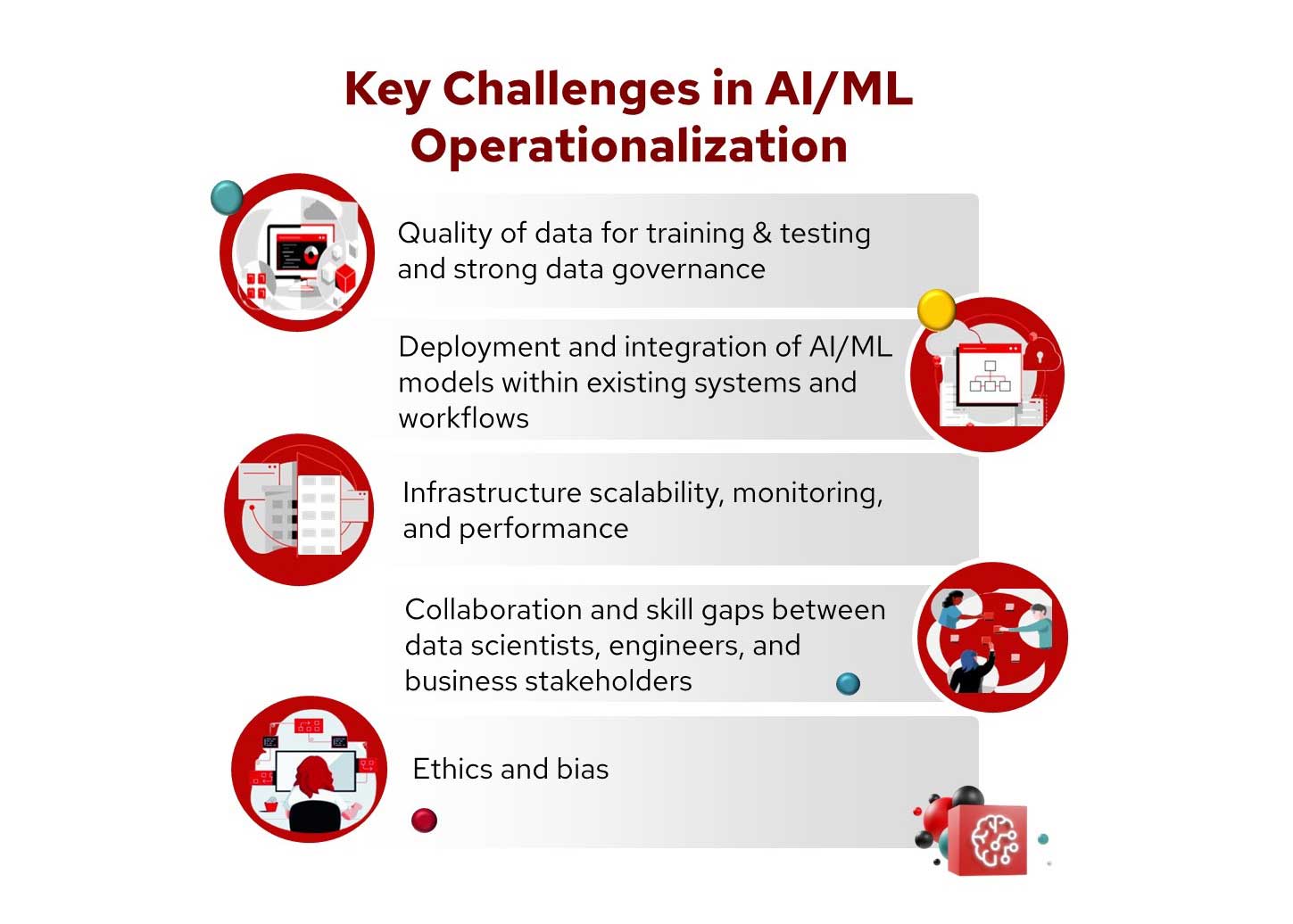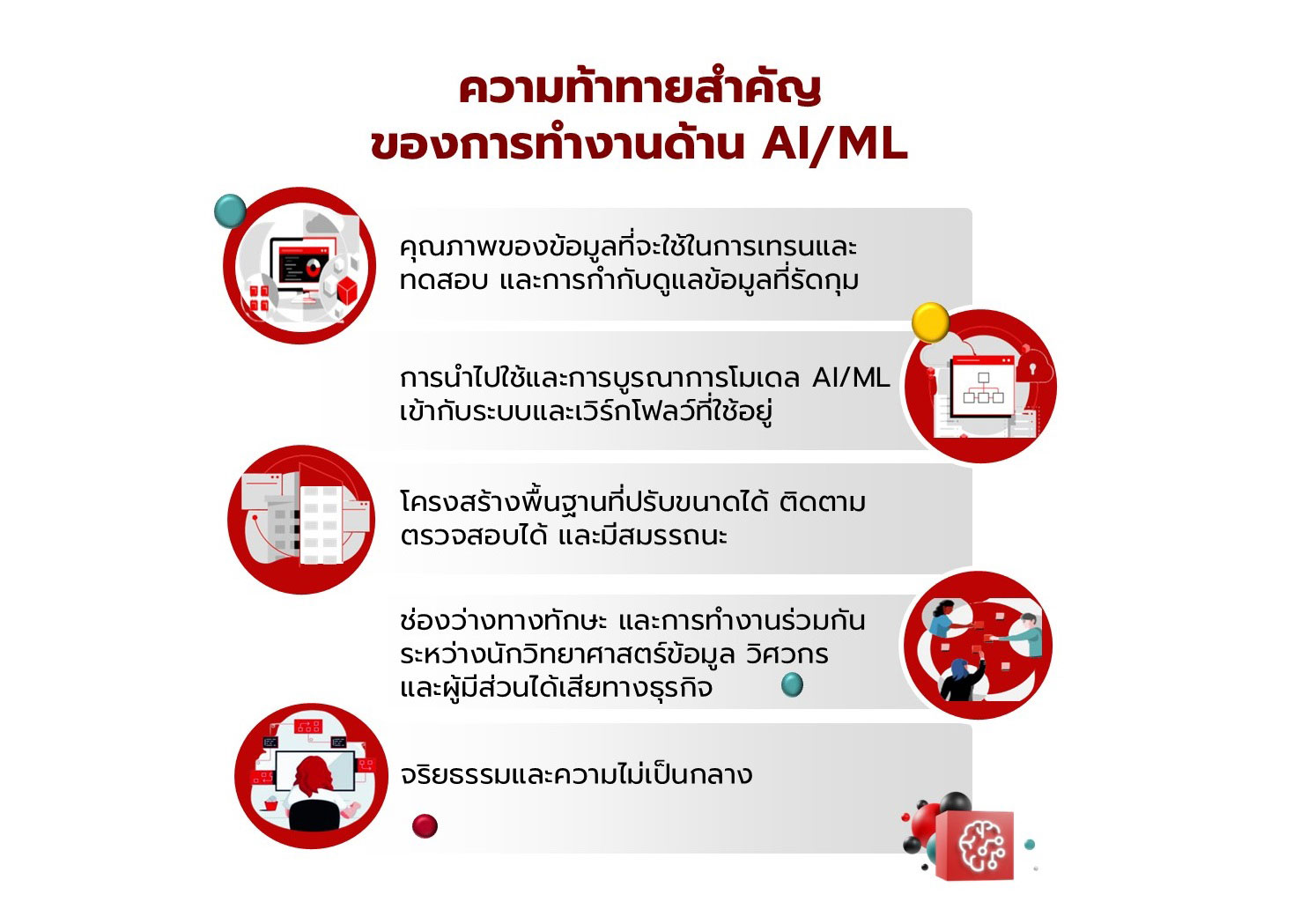AI และ Open Source เป็นตัวกำหนดอนาคตขององค์กรในปี 2568

ตลอดปี 2567 องค์กรธุรกิจต่างได้ทดลองใช้ AI และได้ปลดล็อกศักยภาพของตัวเองด้วยเทคโนโลยีที่เข้ามาสร้างการเปลี่ยนแปลงนี้ ผลสำรวจ McKinsey Global Survey ระบุว่า 65% ของผู้ตอบแบบสอบถามกล่าวว่า องค์กรของพวกเขาใช้ AI เป็นประจำ ซึ่งมีอัตราการนำไปใช้เพิ่มขึ้นเป็นสองเท่าของปี 2566 การที่องค์กรธุรกิจต่างเข้ามามีส่วนร่วมในแลนด์สเคปด้าน AI มากขึ้น ความท้าทายจึงอยู่ที่ธุรกิจแต่ละแห่งจะสร้างความแตกต่างทางการแข่งขันอย่างแท้จริงมากกว่าแค่ตามให้ทันกับความเปลี่ยนแปลงที่เกิดขึ้นได้อย่างไร
องค์กรจะเตรียมรับมือกับสิ่งที่จะเกิดขึ้นอย่างไร
อนาคตของ AI คือโอเพ่นซอร์ส การที่ AI ขยายบทบาทจากการเป็นระบบอัตโนมัติธรรมดาไปเป็นแอปพลิเคชันที่ซับซ้อนมากขึ้น เช่น การวิเคราะห์เชิงคาดการณ์ การสร้างคอนเทนต์ และแม้แต่การตัดสินใจเรื่องต่าง ๆ ทำให้ AI กลายเป็นสิ่งจำเป็นสำหรับองค์กรในทุกอุตสาหกรรม แม้ว่าเส้นทางการใช้ AI ของแต่ละองค์กรจะอยู่ในขั้นตอนที่ต่างกัน แต่โอเพ่นซอร์สช่วยให้ธุรกิจต่าง ๆ รุกสู่ยุคใหม่ของการสร้างสรรค์สิ่งใหม่ ๆ ได้ แนวโน้มสำคัญสามประการที่กำลังจะเกิดขึ้น และจะเป็นปัจจัยขับเคลื่อนการเปลี่ยนแปลงสำคัญขององค์กรต่าง ๆ ในภูมิภาคเอเชียแปซิฟิกในปี 2568 มีดังนี้
#1 เข้าถึงและใช้ข้อได้เปรียบของโอเพ่นซอร์สใน AI
จำนวนโปรเจกต์ open source gen AI เพิ่มขึ้น 98% ตั้งแต่ปี 2566 โดยโปรเจกต์ส่วนใหญ่ริเริ่มมาจากอินเดีย ญี่ปุ่น และสิงคโปร์ สิ่งนี้สะท้อนให้เห็นความสำคัญของการทำงานร่วมกันในการสร้างสรรค์เทคโนโลยีใหม่ ๆ และความสามารถในการเข้าถึงเทคโนโลยีใหม่ ๆ เช่น AI และมีแนวโน้มว่าเราจะได้เห็นความเคลื่อนไหวของ gen AI เพิ่มขึ้นทั่วโลก แพลตฟอร์มและเครื่องมือที่เป็น open source AI รวมถึงโมเดลที่เป็น open source-licensed ทำให้ทุกคนที่เกี่ยวข้องสามารถแบ่งปันความคิดและพัฒนาสิ่งใหม่ ๆ โดยให้ความมั่นใจว่าประโยชน์ต่าง ๆ ของแพลตฟอร์ม เครื่องมือ และโมเดลเหล่านี้ เช่น เฟรมเวิร์กและเครื่องมืออเนกประสงค์ จะไม่จำกัดอยู่เพียงไม่กี่อย่างอีกต่อไป การที่องค์กรทุกขนาดสามารถเข้าใช้ประโยชน์เหล่านี้ได้ จะทำให้การแข่งขันมีความเท่าเทียมกัน แม้แต่องค์กรขนาดเล็กก็สามารถใช้โอเพ่นซอร์สสร้างสรรค์นวัตกรรมในสเกลระดับโลกได้
เมื่อธุรกิจต้องเผชิญกับข้อจำกัดต่าง ๆ เช่น ค่าใช้จ่าย, อำนาจและสิทธิในการควบคุมข้อมูลของตน (data sovereignty), และช่องว่างทางทักษะ โซลูชันโอเพ่นซอร์สสามารถมอบความยืดหยุ่นให้ได้ ผ่านชุมชนโอเพ่นซอร์สที่หลายฝ่ายทำงานร่วมกัน ซึ่งจะช่วยให้ธุรกิจสามารถปรับแต่งโซลูชันให้ตรงตามความต้องการเฉพาะของตน และยังสามารถควบคุมข้อมูลที่ละเอียดอ่อนได้ด้วย นอกจากนี้การทำงานร่วมกันของชุมชนโอเพ่นซอร์สจะทำให้มีผู้ทดสอบผลิตภัณฑ์หรือซอฟต์แวร์เพียงพอที่จะสามารถตรวจพบและแก้ไขข้อบกพร่องได้อย่างรวดเร็ว ช่วยให้ธุรกิจเกิดความเชื่อมั่นในผลลัพธ์ในการใช้ AI มากขึ้น
#2 ไฮบริดคลาวด์เป็นตัวเลือกที่ตั้งเป็นค่าเริ่มต้น
โอเพ่นไฮบริดคลาวด์ ไม่ใช่สิ่งที่เอาไว้ค่อยใช้อีกต่อไป แต่ต้องตั้งเป็นค่าเริ่มต้น ธุรกิจในเอเชียแปซิฟิกควรพิจารณาความสำคัญสามลำดับแรกเพื่อให้ประสบความสำเร็จในยุคที่ลูกค้าเป็นฝ่ายขับเคลื่อน คือ ความเร็ว ความยืดหยุ่น และนวัตกรรม การนำ AI ไปใช้ในการดำเนินธุรกิจในแต่ละวันได้อย่างไม่ยุ่งยาก เป็นสิ่งสำคัญที่จะบรรลุเป้าหมายเหล่านี้ ทั้งยังช่วยให้การดำเนินงานของแต่ละทีมเป็นไปในทิศทางเดียวกัน และรันเวิร์กโหลดได้อย่างยืดหยุ่น ณ สภาพแวดล้อมใดก็ได้ เป็นการสร้างความมั่นใจว่าธุรกิจจะสามารถคงความคล่องตัวและปรับตัวได้
ในประเทศสิงคโปร์ เราพบว่าอุตสาหกรรมบริการทางการเงินเป็นผู้นำในเรื่องนี้ โดยธนาคารทั้งในระดับท้องถิ่นและภูมิภาคใช้ประโยชน์จากไฮบริดคลาวด์กับเวิร์กโหลด AI ทั้งนี้ สิงคโปร์กำลังเป็นจุดเริ่มต้นของธุรกิจที่ขับเคลื่อนด้วย AI ในภูมิภาคเอเชียตะวันออกเฉียงใต้และมีการลงทุนด้าน AI เติบโตขึ้น[2] การจะใช้ประโยชน์จากความล้ำหน้าเหล่านี้อย่างเต็มประสิทธิภาพได้นั้น องค์กรในเอเชียแปซิฟิกจะต้องร่วมมือกับผู้ให้บริการที่เชื่อถือได้ที่นำเสนอความเชี่ยวชาญและโครงสร้างพื้นฐานที่จะช่วยให้เดินหน้าอย่างก้าวกระโดดโดยไม่จำเป็นต้องขยายขนาดการทำงานให้มาก
#3 วางแผนกลยุทธ์ AI เพื่อการเติบโตอย่างยั่งยืน
ChatGPT เป็นสิ่งที่ทำให้ gen AI โดดเด่นและได้รับการรับรู้ในวงกว้าง พลิกโฉมแนวทางที่ธุรกิจใช้เวิร์กโฟลว์ต่าง ๆ และขับเคลื่อนประสิทธิภาพในเวลาที่เกิดความไม่แน่นอน เราอาจเริ่มเห็นองค์กรบางแห่งยึดติดกับผลตอบแทนแบบทันทีจากการใช้ AI ขับเคลื่อนการเปลี่ยนแปลงมากเกินไปและก่อนเวลาอันควร อย่างไรก็ตาม เพื่อปลดล็อกศักยภาพสูงสุดของ AI อย่างแท้จริง องค์กรจำเป็นต้องมีมุมมองในระยะยาว
AI Readiness Barometer ซึ่งเป็นการศึกษาแลนด์สเคปของ AI ดำเนินการโดย Ecosystm ในนาม IBM[3] ได้ทำการประเมินความพร้อมของ AI ตามเกณฑ์สำคัญสี่ประการ คือ วัฒนธรรมและความเป็นผู้นำ, ทักษะและบุคลากร, โครงสร้าง-กระบวนการ-กลยุทธ์พื้นฐานที่ใช้บริหารจัดการและใช้ประโยชน์ข้อมูล, และกรอบการกำกับดูแล แม้ว่าองค์กรในอาเซียนที่ตอบแบบสำรวจจะยกให้ AI มีความสำคัญทางธุรกิจเป็นลำดับต้น ๆ แต่ส่วนใหญ่ยังไม่มีความพร้อม รวมถึงขาดความเชี่ยวชาญ AI ขั้นสูงและแมชชีนเลิร์นนิ่งที่จำเป็นเพื่อใช้ประโยชน์อย่างเต็มศักยภาพ มีผู้ตอบแบบสำรวจเพียง 17% ที่กล่าวว่าองค์กรของตนมีความเชี่ยวชาญอย่างมากและมีทีม data science เฉพาะทาง องค์กรส่วนใหญ่ยังคงขาดทักษะที่เกี่ยวข้องกับ AI และยังไม่เห็นว่าการกำกับดูแลและการปฏิบัติตามข้อกำหนด้านข้อมูลมีความสำคัญ ซึ่งอาจทำให้องค์กรเหล่านี้ต้องเผชิญกับความเสี่ยงด้านกฎระเบียบ
การที่จะใช้ AI ได้อย่างสมบูรณ์แบบนั้น องค์กรต้องใช้แนวทางเชิงกลยุทธ์ที่ต้องให้เวลามากขึ้น โดยเฉพาะในเรื่องซับซ้อนที่ AI สามารถขับเคลื่อนคุณประโยชน์ให้ได้อย่างมาก นอกจากการลงทุนด้านข้อมูลองค์กรและเทคโนโลยี เพื่อเพิ่มความพร้อมของข้อมูลแล้ว องค์กรจำเป็นต้องเตรียมพร้อมทุกระดับ ซึ่งเป็นเรื่องเกี่ยวข้องกับการส่งเสริมวัฒนธรรมแห่งนวัตกรรม, ยกระดับทักษะของบุคลากรให้เปิดรับเทคโนโลยีใหม่ ๆ, และปรับกระบวนการระยะยาวต่าง ๆ ให้สอดคล้องกับเป้าหมายกลยุทธ์ทางธุรกิจ
สิ่งที่จะเกิดขึ้นในปี 2568
เราจะยังเห็น AI พัฒนาไปในบทบาทที่เป็นรากฐานสำคัญของการสร้างสรรค์สิ่งใหม่อย่างต่อเนื่อง การบูรณาการระหว่าง AI และ โอเพ่นเซอร์ที่ลุ่มลึกและแน่นแฟ้นมากขึ้น จะเป็นตัวกำหนดอนาคตของเทคโนโลยี ซึ่งไม่เพียงหมายถึงการเข้าถึงเทคโนโลยีใหม่ ๆ เท่านั้น แต่ยังเพิ่มความสามารถในการปรับตัวและเพิ่มประสิทธิภาพให้กับโซลูชันที่ใช้ในองค์กรในทุกอุตสาหกรรม ทั้งนี้ หัวใจสำคัญของความก้าวหน้าเหล่านี้อยู่ที่ข้อมูลซึ่งเป็นเสาหลักของข้อมูลเชิงลึกที่มีคุณประโยชน์และเชื่อถือได้ เราจะได้เห็นองค์กรต่าง ๆ ให้ความสำคัญกับที่มาของข้อมูลมากขึ้น ทั้งภาพรวมของต้นทางที่เกิดข้อมูล ความสมบูรณ์ และความถูกต้องของข้อมูลขององค์กร และสร้างความไว้วางใจสูงขึ้นมากในโลกที่ขับเคลื่อนด้วย AI มากขึ้นเรื่อย ๆ
เราก้าวสู่ปี 2568 ปีที่เทรนด์ที่เกี่ยวเนื่องกันเหล่านี้จะเป็นตัวกำหนดแลนด์สเคป AI ที่สมบูรณ์มากขึ้น เป็นการปูทางให้กับอนาคตที่ธุรกิจทุกขนาดสามารถปลดล็อกศักยภาพของข้อมูลและเทคโนโลยีได้ด้วยโอเพ่นซอร์ส






